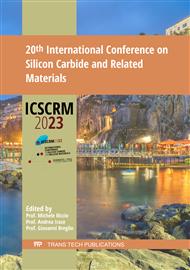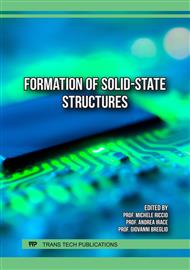p.41
p.47
p.53
p.59
p.65
p.71
p.79
p.85
p.91
Ni/4H-SiC Ohmic Contact Formation Using Multipulse Nanosecond Laser Annealing
Abstract:
Nowadays, the growing worldwide electrification requires new materials for power management. SiC currently dominates the market thanks to excellent energy efficiency and broad operating capabilities. The present paper proposes an experimental study of the Ni-SiC backside ohmic contact formation using 308 nm nanosecond laser annealing (NLA). After Nickel (80 nm) sputtering over 4H-SiC wafers, various laser conditions are investigated, with energy density (ED) ranging from 2.4 to 5.4 J/cm², pulse number from 1 to 20 and chuck temperature from 25 °C (RT) to 400 °C. For all series, a common scenario is noticed as the ED increases, with first solid-state reactions, then local melt and, finally, complete top layer melt and de-wetting at high ED. An in-depth understanding of the impact of laser conditions on these stages is achieved, based on electrical data, Raman spectroscopy, optical microscopy, Scanning Electron Microscopy (SEM) and Scanning Transmission Electron Microscopy (STEM). Results reveal that both high pulse numbers and the use of a hot chuck enable to significantly reduce the ED needed to form low resistance contacts. In addition, sheet resistances and contact resistivities are linked to the microstructure evolution upon NLA exposure. As a proof-of-concept, an acceptable process point yields a contact resistivity around 5×10-5 Ω cm² when the wafer is processed at 25 °C and a value as low as 10-5 Ω cm² for 400 °C processing. The mechanisms involved and discussed in the present work may very likely pave the way for other contact formation with limited thermal budget.
Info:
Periodical:
Pages:
65-70
Citation:
Online since:
August 2024
Keywords:
Permissions:
Share:
Citation:



